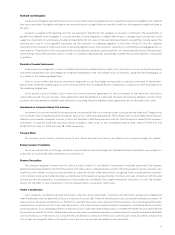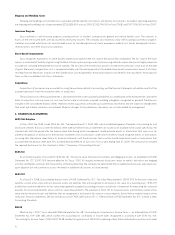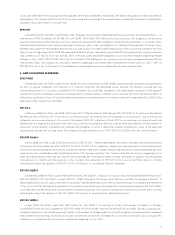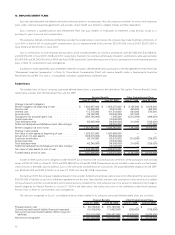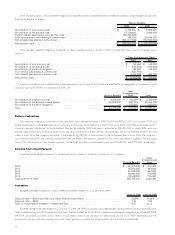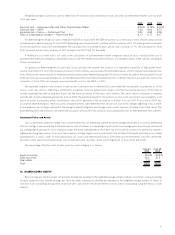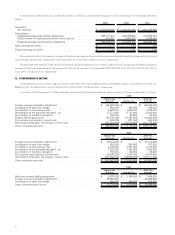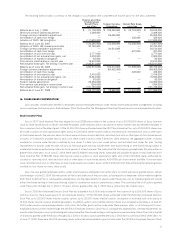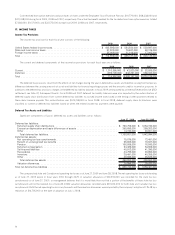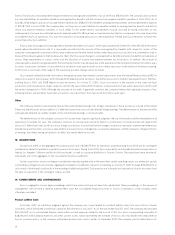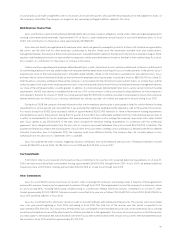Sysco 2009 Annual Report Download - page 71
Download and view the complete annual report
Please find page 71 of the 2009 Sysco annual report below. You can navigate through the pages in the report by either clicking on the pages listed below, or by using the keyword search tool below to find specific information within the annual report.
Weighted-average assumptions used to determine net company-sponsored pension costs and other postretirement benefit costs for each
fiscal year were:
2009 2008 2007
Discount rate — Retirement Plan and Other Postretirement Plans . .............................. 6.94% 6.78% 6.73%
Discount rate — SERP ............................................................. 7.03 6.64 6.73
Expected rate of return — Retirement Plan ............................................... 8.00 8.50 9.00
Rate of compensation increase — Retirement Plan. ......................................... 6.17 6.17 6.17
For determining the net pension costs related to the SERP for fiscal 2009, the SERP calculations assumed various levels of base salary increase
and decrease for determining pay for fiscal 2009 depending upon the participant’s position with the company and a 7% salary growth assumption
for all participants for fiscal 2010 and thereafter. The calculation for fiscal 2008 assumes annual salary increases of 7%. The calculation for fiscal
2007 assumed annual salary increases of 10% through fiscal 2007 and 7% thereafter.
A healthcare cost trend rate is not used in the calculations of postretirement benefit obligations because Sysco subsidizes the cost of
postretirement medical coverage by a fixed dollar amount, with the retiree responsible for the cost of coverage in excess of the subsidy, including all
future cost increases.
For guidance in determining the discount rate, Sysco calculates the implied rate of return on a hypothetical portfolio of high-quality fixed-
income investments for which the timing and amount of cash outflows approximates the estimated payouts of the company-sponsored pension
plans.The discount rate assumption is reviewed annually and revised as deemed appropriate.The discount rate to be used for the calculation of fiscal
2010 net company-sponsored benefit costs for the Retirement Plan and Other Postretirement Plans is 8.02%. The discount rate to be used for the
calculation of fiscal 2010 net company-sponsored benefit costs for the SERP is 7.14%.
The expected long-term rate of return on plan assets is derived from a mathematical asset model that incorporates assumptions as to the
various asset class returns, reflecting a combination of rigorous historical performance analysis and the forward-looking views of the financial
markets regarding the yield on long-term bonds and the historical returns of the major stock markets. The rate of return assumption is reviewed
annually and revised as deemed appropriate. In fiscal 2009, the expected long-term rate of return on plan assets assumption was changed to a net
return on assets assumption, which contributed to the 0.50% decrease in the assumption to 8.00% in fiscal 2009. Prior to fiscal 2009, this
assumption represented gross return on assets, and plan expenses were reflected within service cost. Due to this change, beginning in fiscal 2009,
actual expenses are no longer reflected in the change in benefit obligation and change in plan assets sections of funded status table above. The
expected long-term rate of return to be used in the calculation of fiscal 2010 net company-sponsored benefit costs for the Retirement Plan is 8.00%.
Investment Policy and Assets
Sysco’s investment objectives target a mix of investments that can potentially achieve an above-average rate of return. Sysco has determined
that this strategy is appropriate due to the relatively low ratio of retirees as a percentage of participants, low average years of participant service and
low average age of participants and is willing to accept the above-average level of short-term risk and variability in returns to attempt to achieve a
higher level of long-term returns. As a result, the company’s strategy targets a mix of investments that include 67.5% equity (including a mix of large
capitalization U.S. stocks, small- to mid-capitalization U.S. stocks and international stocks), 30% fixed income investments and 2.5% real estate.
Securities within fixed income investments may include derivative securities, which were insignificant in fiscal 2009 and 2008.
The percentage of the fair value of plan assets by asset category is as follows:
June 27,
2009
June 28,
2008
Equity securities ..................................................................... 60.6% 68.8%
Debt securities ...................................................................... 38.1 31.2
Real estate ......................................................................... 1.3 —
Total . ............................................................................. 100.0 100.0
14. SHAREHOLDERS’ EQUITY
Basic earnings per share has been computed by dividing net earnings by the weighted average number of shares of common stock outstanding
for each respective year. Diluted earnings per share has been computed by dividing net earnings by the weighted average number of shares of
common stock outstanding during those respective years adjusted for the dilutive effect of stock options outstanding using the treasury stock
method.
51


